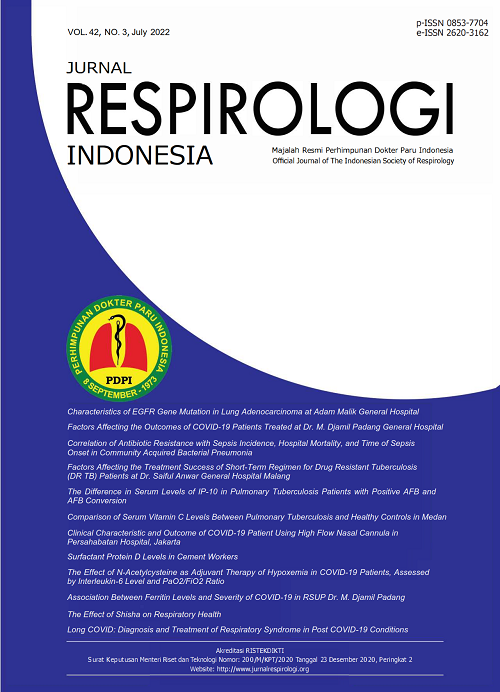Characteristics of EGFR Gene Mutation in Lung Adenocarcinoma at Adam Malik General Hospital
DOI:
https://doi.org/10.36497/jri.v41i1.156Keywords:
Adenocarcinoma, EGFR, Lung CancerAbstract
Background: Epidermal growth factor (EGFR) is a transmembrane receptor that plays an important role in the development of cancer phenotypes. Some patients with lung cancer have genetic mutations. Several studies have found a close correlation of EGFR gene mutation with 15-20% of lung adenocarcinoma cases. This study aimed to determine the EGFR profile in adenocarcinoma lung cancer patients at Haji Adam Malik General Hospital.
Methods: This was a prospective cohort study conducted at Haji Adam Malik General Hospital, Medan. This study used patients data for 3 years, starting from January 1, 2014 to D1ecember 31, 2016. The sample size in this study was 34 patients. The data were then analyzed using SPSS.
Results: All patients were adenocarcinoma lung cancer patients with positive EGFR mutation. There were 9 subjects with EGFR mutation in exon 19; 11 subjects with exon 21 L858R mutation; and 3 subjects with exon 21 L861Q mutation. Meanwhile, there were 3 subjects with uncommon EGFR mutations, namely exon 18 mutation. Majority of subjects with exon 19 mutation were male, aged >60 years, smokers with mixed types of cigarettes and severe brinkmann index. In subjects with exon 21 L858R mutation, most of the patients were male, aged 50-60 years, smokers with mixed cigarette types and severe brinkmann index. The same characteristics were also observed in subjects with exon 18 mutation. However, for exon 21 L861Q mutation, the majority of subjects were female with varying ages, and were not smokers.
Conclusion: Most of the study subjects profiles were male, aged over 60 years, smokers, with mixed types of cigarettes, and with severe Brinkman Index. The EGFR mutations most commonly occured in exon 21, followed by exon 19 (ins/del exon 19), exon 18, and a combination of 2 exons.
Downloads
References
Sung H, Ferlay J, Siegel RL, Laversanne M, Soerjomataram I, Jemal A, et al. Global Cancer Statistics 2020: GLOBOCAN Estimates of Incidence and Mortality Worldwide for 36 Cancers in 185 Countries. CA Cancer J Clin. 2021;71(3):209–49.
The Global Cancer Observatory. Indonesia Fact Sheet [Internet]. International Agency for Research on Cancer. 2020. Available from: https://gco.iarc.fr/today/data/factsheets/populations/360-indonesia-fact-sheets.pdf
Travis WD, Brambilla E, Nicholson AG, Yatabe Y, Austin JHM, Beasley MB, et al. The 2015 World Health Organization Classification of Lung Tumors: Impact of Genetic, Clinical and Radiologic Advances Since the 2004 Classification. Vol. 10, Journal of thoracic oncology : official publication of the International Association for the Study of Lung Cancer. United States; 2015. p. 1243–60.
Inamura K. Lung Cancer: Understanding Its Molecular Pathology and the 2015 WHO Classification. Front Oncol. 2017;7:193.
George J, Lim JS, Jang SJ, Cun Y, Ozretić L, Kong G, et al. Comprehensive genomic profiles of small cell lung cancer. Nature. 2015;524(7563):47–53.
Hammerman PS, Lawrence MS, Voet D, Jing R, Cibulskis K, Sivachenko A, et al. Comprehensive genomic characterization of squamous cell lung cancers. Nature. 2012;489(7417):519–25.
The Cancer Genome Atlas Research Network. Comprehensive molecular profiling of lung adenocarcinoma. Nature. 2014;511(7511):543–50.
Yoon H-Y, Ryu J-S, Sim YS, Kim D, Lee SY, Choi J, et al. Clinical significance of EGFR mutation types in lung adenocarcinoma: A multi-centre Korean study. PLoS One. 2020;15(2):e0228925.
Midha A, Dearden S, McCormack R. EGFR mutation incidence in non-small-cell lung cancer of adenocarcinoma histology: a systematic review and global map by ethnicity (mutMapII). Am J Cancer Res. 2015;5(9):2892–911.
Shankar S, Thanasekaran V, Dhanasekar T, Duvooru P. Clinicopathological and immunohistochemical profile of non-small cell lung carcinoma in a tertiary care medical centre in South India. Lung India. 2014;31(1):23–8.
Linardou H, Dahabreh IJ, Bafaloukos D, Kosmidis P, Murray S. Somatic EGFR mutations and efficacy of tyrosine kinase inhibitors in NSCLC. Nat Rev Clin Oncol. 2009;6(6):352–66.
Ciardiello F, Tortora G. EGFR Antagonists in Cancer Treatment. N Engl J Med. 2008;358(11):1160–74.
Jang T. Clinical Features in Advanced Lung Cancer Patients With EGFR Common Mutations. Chest. 2016;150(4):709A.
Syahruddin E, Wulandari L, Sri Muktiati N, Rima A, Soeroso N, Ermayanti S, et al. Uncommon EGFR mutations in cytological specimens of 1,874 newly diagnosed Indonesian lung cancer patients. Lung Cancer (Auckland, NZ). 2018;9:25–34.
Soeroso N, Soeroso L, Syafiuddin T. Kadar Carcinoembryogenic Antigen (CEA) Serum Penderita Kanker Paru Karsinoma Bukan Sel Kecil di RSUP Adam Malik. J Respirologi Indones. 2014;34(1):17–25.
Tseng C-H, Chiang C-J, Tseng J-S, Yang T-Y, Hsu K-H, Chen K-C, et al. EGFR mutation, smoking, and gender in advanced lung adenocarcinoma. Oncotarget. 2017;8(58):98384–93.
Xu J, Jin B, Chu T, Dong X, Yang H, Zhang Y, et al. EGFR tyrosine kinase inhibitor (TKI) in patients with advanced non-small cell lung cancer (NSCLC) harboring uncommon EGFR mutations: A real-world study in China. Lung Cancer. 2016;96:87–92.
Wu Y-L, Fukuoka M, Mok TSK, Saijo N, Thongprasert S, Yang JCH, et al. Tumor response and health-related quality of life in clinically selected patients from Asia with advanced non-small-cell lung cancer treated with first-line gefitinib: post hoc analyses from the IPASS study. Lung Cancer. 2013;81(2):280–7.
Chang S, Hur J, Hong YJ, Lee H-J, Kim YJ, Han K, et al. Adverse Prognostic CT Findings for Patients With Advanced Lung Adenocarcinoma Receiving First-Line Epidermal Growth Factor Receptor-Tyrosine Kinase Inhibitor Therapy. AJR Am J Roentgenol. 2018;210(1):43–51.
Paez JG, Jänne PA, Lee JC, Tracy S, Greulich H, Gabriel S, et al. EGFR mutations in lung cancer: correlation with clinical response to gefitinib therapy. Science. 2004;304(5676):1497–500.
Downloads
Additional Files
Published
Issue
Section
License
- The authors own the copyright of published articles. Nevertheless, Jurnal Respirologi Indonesia has the first-to-publish license for the publication material.
- Jurnal Respirologi Indonesia has the right to archive, change the format and republish published articles by presenting the authors’ names.
- Articles are published electronically for open access and online for educational, research, and archiving purposes. Jurnal Respirologi Indonesia is not responsible for any copyright issues that might emerge from using any article except for the previous three purposes.
















